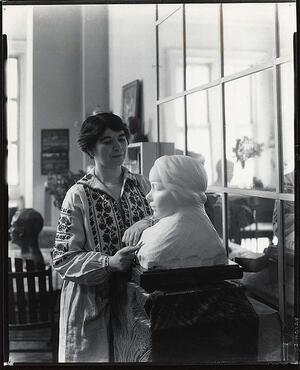War memorial by Bashka Paeff dedicated in Kittery, Maine
On May 31, 1926, a bas-relief bronze and granite memorial to the sailors and soldiers from Maine who died in World War I was dedicated in the coastal town of Kittery. It depicted a woman fiercely protecting her child, a dramatic departure from most war memorials that feature soldiers and guns. The sculptor was Bashka Paeff, a Jewish woman, whose family had emigrated from Russia to escape the pogroms.
Born in 1893, she grew up in Boston’s crowded North End. She studied at the Massachusetts Normal Art School, the Boston Museum School, and at the MacDowell Colony in New Hampshire. She financed her studies working as a toll collector on the Boston subways.
After a state-sponsored competition, Gov. Percival P. Baxter had commissioned the work. It took one and a half years to create and earned Paeff a $15,000 fee, including the costs of casting and installing the sculpture.
In the years after World War I, when feelings about pacifism and militarism ran high, the work became controversial. When it was almost completed, the man who succeeded Baxter as governor objected to it as “too pacifistic.” Paeff compromised by adding a few soldiers in low relief in the background, as well as military inscriptions. While she called the statue “The Horrors of War,” it was officially named “Sacrifices of War.” Most Mainers know it as the “Sailors and Soldiers Memorial.” See photos of the memorial here.
Bashka Paeff clearly intended the sculpture to be a statement against war. “I have some decided opinions about war memorials,” she said. “I hope most of all that we shall not erect memorials to glorify war… We forget what suffering and horror it brought. We should set up memorials that would make us loathe war instead of admire it.”
Paeff produced another war memorial, this one in the Massachusetts State House honoring Bay State chaplains who died during World War I. She also created a relief sculpture of the Minutemen who fought in the first battle of the American Revolution. Her other works include busts of Martin Luther King, Jane Addams, Oliver Wendell Holmes, and Ellen Richards. She made a marble bust of Louis Brandeis.
The home and studio Paeff occupied on the north slope of Beacon Hill still stands. Passersby can see the large windows that brought light into her work space.
Sources
Charlotte Streifer Rubinstein, American Women Sculptors: A History of Women Working in Three Dimensions, Boston, G.K.Hall, 1990; Jennifer Wingate, “Motherhood, Memorials, and Anti-Militarism: Bashka Paeff’s “Sacrifices of War, Women’s Art Journal, Vol. 29, no. 2, page 31.




There are also two sculptures by Bashka Paeff in the Public Gardens: one of a boy and his dog and another of a child holding a bird.
Wonderful to read and listen to these appreciations of Paef, however: (1) Although Boston deserves credit for raising and educating her, please note that she is not a "native" of the city; she was born in Minsk in Russia. Her status as an immigrant from Russia, and a Jew, raises the profile of her courage. The Sedition Act of 1919 and the subsequent arrests and deportations of Russian immigrants by J. Edgar Hoover and Mitchell Palmer, could not have made America comfortable for Paef's family. Nevertheless, in that anti-immigrant, anti-intellectual atmosphere, as a very young woman bearing targetted ethnicities, she teamed up with Governor Baxter to publicly fight for her pacifist principles. (2) The video emphasizes her Boston Museum School grad education over her undergrad program at Mass. Normal Art School. Tuition at the Normal Art School in those years was zero (or negligible). It was almost the only access to a professional art education available to working-class immigrant families at the time. Paef demonstrated her appreciation for her public-school alma mater by returning to lecture at the school.